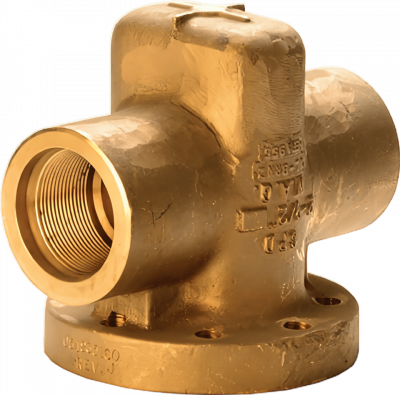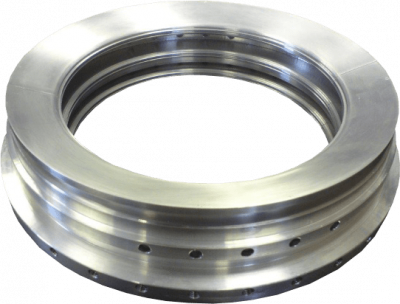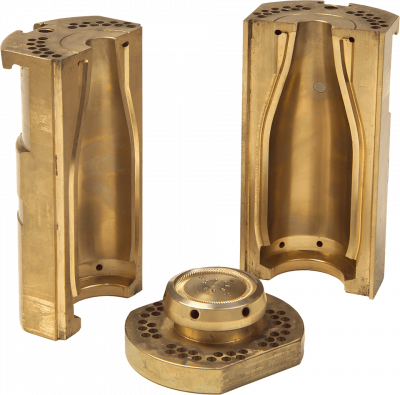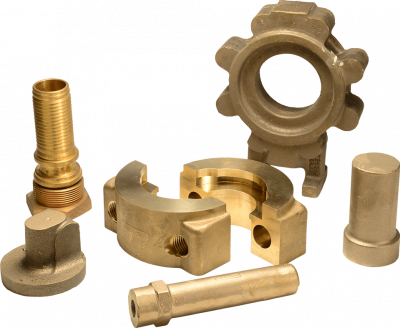Key Takeaways About Sand Casting Manufacturers
- Sand casting manufacturers use a process in which parts are made by pouring molten metal into a mold that is made from sand.
- Green sand is a type of sand that has moisture, and it is particularly useful for sand casting manufacturing due to its affordability and recyclability.
- Erie Bronze & Aluminum utilizes technology and decades of experience in our casting processes to minimize costs and turnaround times all while ensuring high-quality results.
- Our non-leaded bronze sand castings crafted in-house at our state-of-the-art facility can be used in a wide variety of industrial applications.
The sand casting manufacturing process allows for quite a few advantages compared to many other methods like die casting or investment casting. That’s only the beginning, however, as the process can additionally offer a fast turnaround on quotes and orders, and working with the right manufacturer allows for convenient flexibility. With help from Erie Bronze & Aluminum, you can expect exceptional casting quality thanks to our focus on technology and quality control that matches your exact specifications.
We are a small company with 24 employees, and we have produced castings for the U.S. government such as catapult system guides, aluminum labyrinth compressor seals, bronze extension fittings, cylinder heads and bodies, and various bronze and aluminum castings for Naval sea systems. Our experience and commitment have allowed us to become a corporate member of the American Foundry Society and a member of the Non-Ferrous Founders’ Society.
Our commitment to 100% customer satisfaction 100% of the time is driven by technology-based solutions that seek to modernize the sand casting process while other companies may rely more on traditional techniques. Take a closer look at how our team stands out among sand casting manufacturers, and discover how we can help you with your next project.
What is Sand Casting?
Sand casting is a specific kind of metal casting manufacturing technique that utilizes custom molds crafted from sand. Sand is used to create a mold to the specifications of the specific part that is to be made. Then, molten metal is poured into the mold to craft the part while maintaining the exact specifications.
Much of the sand casting process is automated, which reduces manufacturing costs significantly and consequently lowers prices compared to how it was in the past, though EBA is uniquely equipped with advanced simulation technology that other sand casting manufacturers may not have. Additionally, the materials and labor required for sand casting are generally more affordable than alternatives like investment casting. The improved speed and strength of this sand manufacturing process has made it popular in automotive applications, but its versatility allows a wide range of industries to benefit.
The Sand Casting Process
To best understand why sand cast parts are so reliable, you will need to know the sand casting process.
- Pattern Production: The first step is to produce a pattern to the specifications of the final product including any finer details that it may include. The physical pattern can be made from a variety of different materials like wood or metal, but the ultimate purpose is to create the mold.
- Gate System: To allow for the molten metal pour later on, the pattern will need a gate system attached to it. This typically comes in the form of a series of tunnels with a pouring cup.
- Sand Packing: With the pattern and gate system in place, sand is then packed around the pattern and gate system. This is done in two parts with the top part being called the “cope” and the bottom part being called the “drag.”
- Removal of the Pattern: Once the sand is packed and set, the cope is taken off of the drag and the pattern is removed from the interior. Then, the cope is put back on top of the drag, which finalizes the mold, leaving a cavity in the perfect shape of the pattern.
- Metal Pouring: When the mold is ready, molten metal is poured in through the gate system until the cavity inside is completely filled. Since the gate system includes a series of tunnels or risers, any shrink is going to be concentrated in those tunnels rather than in the pattern cavity itself.
- Part Extraction: Once the molten metal has cooled, the part is ready to be extracted from the mold. During the extraction process, the mold is typically broken away with the sand itself being captured to be reused later.
- Final Processing: Finally, the part is then cut from the gate system and treated to match the original pattern dimensionally at the point where the gate system was attached. Depending on the part, final processing may also include grinding, non-destructive testing, and sandblasting.
Cores
Some parts have internal dimensions in addition to the exterior dimensions, which requires an extra step in the manufacturing process. Before putting the cope and drag back together after removing the pattern, cores need to be added. Typically made from sand or some type of metal, cores take the shape of whatever internal structures the part may require. With the cores in place, the molten metal will solidify around it leaving the core’s area behind as empty space within.
Recycling
After the sand casting process is done, the sand used is recycled to be used again in future applications. After sand is shaken off a finished part, it is typically stuck together in several lumps. To recycle it, these lumps are cooled and crushed while metal granules that may be present are removed. What is left is then screened for any anomalies before being reintroduced as sand ready for the next casting.
The Sand in Sand Casting
In sand casting processes, there are two primary types of sand that are used. Green sand is the most common, but some will alternatively use resin sand. While they both have their advantages, utilizing bronze alloys tends to work best with green sand.
Green Sand
Green sand is a type of sand that is moist and composed of mostly silica sand alongside clay and water. While the green label refers to its moisture content rather than its literal color, it can be considered green in the sense that this sand is recyclable. By combining the clay and the sand with moisture from water, a solid mold can be formed while ensuring that the sand remains uncured during the pouring process.
Crafting molds using green sand is done using either an automated molding line or a cope drag molding line. With an automated molding line, bronze sand casting can be done for casts up to 150 pounds. The cope drag molding line is better suited for larger bronze sand castings that weigh up to 500 pounds.
Resin Sand
Resin sand works by combining sand with resin and inducing a chemical reaction to craft hard molds. Specialized equipment is required simply to facilitate this, so it tends to be much more expensive than green sand molds. While this type of sand is great at producing exceptionally smooth surfaces in final products, the overall cost and initial startup costs are significant compared to the much more affordable green sand. Plus, resin sand is more difficult to recycle.
Properties of Sand
Numerous properties that affect the usability of sand, so they will all need to be considered before moving forward with sand casting.
- Strength: The strength of sand specifically refers to how well it can hold its shape when submitted to stress factors.
- Permeability: The permeability of sand refers to how easily it is for gasses to escape during the process of casting.
- Moisture: Green sand earned its name due to its moisture content, but the specific amount of moisture matters. Too little, and the sand may not bind properly. Too much, and you may find steam bubbles trapped in the casting.
- Flowability: Sand flowability refers to how well the sand will be able to fit in smaller areas. If a pattern has tight angles or intricate cores, the sand used for the mold will need a higher flowability.
- Reusability: The reusability of manufacturing sand refers to how easily it can be recycled and used again for other sand castings. Green sand is especially adept when it comes to reusability, which makes green sand typically more affordable.
- Size: The size of the individual grains of sand can play a major role in its casting applications, as smaller grain sizes tend to offer stronger molds while larger grain sizes tend to be more permeable.
- Shape: Sand casting typically uses three different shapes for sand casting applications. Rounded grains offer good flowability with weaker bonding while angular grains do the opposite. Sub-angular grains are a middle ground between the other two.
Benefits of Sand Casting Manufacturing
The sand casting process allows for a number of advantages compared to alternative processes like die casting or investment casting, especially when it comes to prototype castings, component conversion, and other low- to medium-volume production needs. Here are some of the most notable advantages.
- Lower overall costs
- Lower initial setup cost
- Metals used can be ferrous or non-ferrous
- Shorter lead time
- Easier to modify than other processes
Applications of Sand Casting
The sand casting process can benefit a wide range of industries thanks to its dimensional range and affordability. Here are just a few applications that the sand casting process’s exact specifications can work for.
- Engine blocks
- Cylinder heads
- Transmission cases
- Aerospace components
- Landing gear
- Pipes
- Pumps
- Valves
- Turbines
- Compressors
- Military and defense
- Electrical appliances
- Artworks
- Industrial hardware tools
Simulation Software in Manufacturing
At Erie Bronze & Aluminum, our engineering department is committed to maximizing efficiency while still maintaining the quality that you deserve in all sand cast products. That is why we use SOLIDCast and FLOWCast software in our process.
By offering flow simulation, we can get a better idea of how the liquid metal will fill a mold and how the transferring of heat would occur during the process. Different parts, different materials, and all the other different aspects of a part could affect the heating requirements of the mold. By simulating the metal pouring before actually moving forwards, we can be sure that our castings will produce the high quality completed part you deserve.
Flow simulation software adds several benefits to our process that you get to enjoy with the completed product.
- Reduces overall costs
- Shortens lead times
- Produces higher quality castings
- Reduces time spent on sampling and inspection
- Reduces the weight of mold material
Since simulation software helps eliminate wasted time and material, efficiency is enhanced significantly. That is how we are able to offer our sand casting manufacturing services while allowing you to save money.
Bronze Alloy Specialization
Erie Bronze & Aluminum offers quite a few different non-leaded bronze alloys for uses across multiple industries. All the metals used in our manufacturing process are alloyed in-house using our SPECTROLAB metal analyzer. We have experience working with casting material specifications in aerospace applications, ASTM, military, and more.
Our specializations include the four following bronze alloys.
- Aluminum Bronze: These alloys are best used in circumstances where you need a material that is resistant to corrosion. They are common in applications that have frequent or constant contact with chlorides, dilute acids, seawater, and a variety of other harsh environments. Any alloy containing more than 10% aluminum can be heat treated too to boost its mechanical properties in environments that will subject the alloy to greater wear and tear. Since these alloys are considered non-sparking, they can be used for equipment that is meant to handle petroleum, gas products, explosives, and anything else that may start a fire.
- Manganese Bronze: With manganese bronze alloys, you’ll have the strongest type of bronze alloy that is perfect for use in heavy-duty mechanical products. They can handle heavy loads and high speeds all while offering high tensile and yield strength. Despite their massive strength, they can be poured at a reasonable cost when utilizing the sand casting manufacturing process. Additionally, they offer mild corrosion resistance, but their strength is the most important feature.
- Tin Bronze: When you utilize tin bronze, you’ll have an alloy that has reasonably high strength, a lower coefficient of friction compared to steel, and excellent wear resistance. This alloy is adept at taking impact loads with reduced surface speeds making them ideal for applications like moveable bridge components. Because of these properties, they are most additionally used in applications like gears, bearings, and piston rings. Plus, they offer similar corrosion resistance to aluminum bronze alloys.
- Silicon Bronze: For the most part, silicon bronze alloys are used in pump and valve components, but it can also work in bearings and gears. Their main feature is immense corrosion resistance when it is submerged in liquids or chemicals while still offering moderate strength. Valve and intricately shaped pump components typically have very specific and strict dimensional requirements, so sand casting is a great way to meet the necessary specifications.
Bronze Casting Specifications
At Erie Bronze & Aluminum, we can work with a variety of sand casting specifications. The following are just a few of the most common that we have extensive experience with.
- ASTM B148 – This Specification Establishes Requirements for Sand Castings Produced from Copper-Base Alloys
- AMS 4860 – Manganese Bronze, Sand, and Centrifugal Castings
- ASTM B584 – Standard Specification for Copper Alloy Sand Castings for General Applications
- ASTM B763 – Standard Specification for Copper Alloy Sand Castings for Valve Applications
- MIL-B- 21230A – Military Specification, Bronze, Nickel Aluminum, and Manganese-Nickel Aluminum Castings, Ship Propeller Application
- QQ-C- 390 – Military Specification Copper Alloy Castings
Why You Should Partner with Erie Bronze & Aluminum
At Erie Bronze & Aluminum, we are a leading bronze and aluminum sand casting manufacturer in Erie, PA with a commitment to high-quality bronze sand casting with efficiency and accuracy. By emphasizing technology and quality control with our manufacturing process, our productions are done to your exact specifications. Our specialization in non-leaded bronze sand castings applies to several industrial applications all around the world.
When you work with us, you can expect:
- An exceptional casting quality
- A fast turnaround on quotes and orders
- Flexibility and a team that’s easy to work with
Our state-of-the-art facility is only the beginning, however, as you can also benefit from our decades of experience in the foundry industry. Our elite team has the knowledge and experience to help you choose the best alloy for your application and specifications. We take the time to understand your unique requirements and work to offer the best solution that will fit your circumstances. In addition to our Bronze sand casting capabilities, we also offer manufactured aluminum tubes & rings in three hard-to-find alloys.
Certification Options
If you need certification for your products, we have three options to consider.
- Certificate of Conformity: This certification details the chemical ranges of your required specifications as well as a statement that the castings you receive will conform to that specification. It is important to note that this certification does not report the actual chemical results.
- Chemical Certification: This certification shows that your castings meet the required chemical specifications and does show the actual chemical results.
- Chemical & Physical Certification: With this certification, you can show that your castings meet both the necessary chemical specifications and required physical properties. The explicit results from our in-house laboratory testing will be included.
Foundry Degassing Unit
Erie Bronze & Aluminum is the first US-based foundry to utilize the latest in metal treatment and gas analyzing technology that was recently developed in Europe. By using this advanced technology, we can control the hydrogen levels of our aluminum alloys in real time directly within the molten metal itself. This allows us to offer an improved surface finish, increased tensile strength, and a reduction of hard inclusions.
Frequently Asked Questions
What is the difference between sand casting and die casting?
Sand casting uses sand to create molds while die casting uses a metal mold known as a die. The most notable benefit of using a die is that it can be reused after you cast a part in it. Because of its reusability, it is especially useful for high-volume projects in which you need to make many copies of the same part.
Of course, crafting the die in the first place is much more arduous and complex than using a sand mold, so savings do not typically follow unless you have high-volume production requirements. Additionally, die casting often leads to the cast having defects like pores and surface projections while sand casting manufacturers have tools to reduce those potential problems.
What is the difference between sand casting and investment casting?
Investment casting is also known as lost wax casting, and it involves molding wax into the cast shape and then coating it with a refractory material like ceramic. Then, heat is applied to melt out the wax leaving behind a mold that can then be filled with molten metal to cast a part. To recover the part after the poured molten metal cools, the refractory material shell is broken apart around it.
Compared to sand casting, investment casting is much more time consuming in terms of how long it takes to create the mold itself. Plus, the necessary materials for investment casting like ceramic or paraffin wax tend to be more expensive compared to the sand and clay used in green sand casting. Sand casting manufacturers additionally offers a wider range of casting capabilities while investment casting is typically only used for steel castings.
What is the typical lead time?
While lead time is affected by factors like complexity, cores, heat treating, testing, and more, the typical lead time ranges from 3 to 9 weeks for initial first-run products and 1 to 6 weeks for production run items.
Is sand casting manufacturing eco-friendly?
Yes, sand casting manufacturing is eco-friendly thanks to our use of green sand and scrap metal. By utilizing recycled materials rather than “virgin” materials, we are able to pass on savings to clients while also creating less waste in the world.
Is sand casting a reliable process?
Yes, sand casting is a reliable process, as it has been consistently refined for thousands of years. The first sand casting process dates back to 1600 BCE in China in which it was used to craft artworks and statues. Since the rise of automotive and aviation industries in the 20th century, however, sand casting has become an integral aspect of producing parts with accurate specifications. In the modern day, new technology has augmented this process even further utilizing simulation software for metal pouring.
Request a Quote from Erie Bronze & Aluminum
If you are ready to pursue bronze sand castings to your exact specifications, the team at Erie Bronze & Aluminum is happy to help. You can tell us the kind of alloy you want used in your project or have a discussion with our engineers to determine which would work best for your needs. Get in touch with our sand casting manufacturers at 814.838.8602 or fill out our online contact form today to request a quote for your next project.




